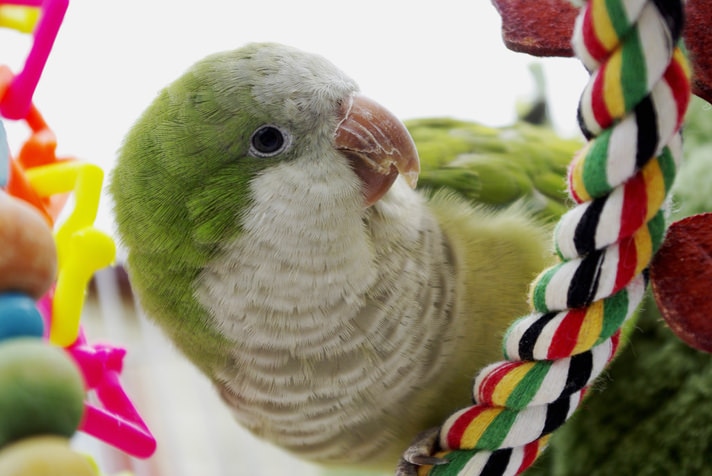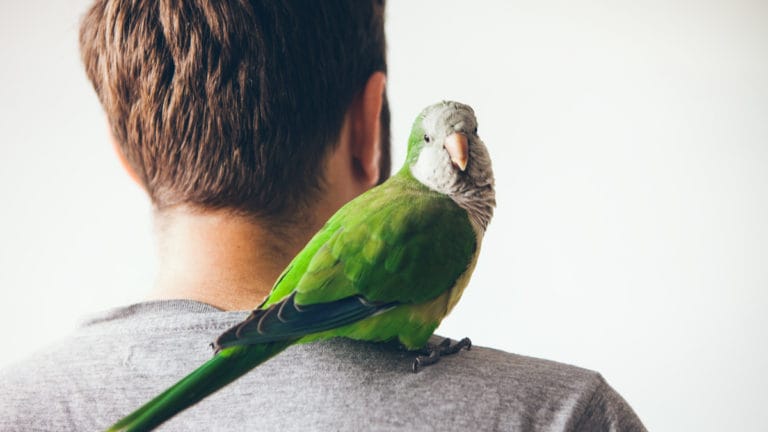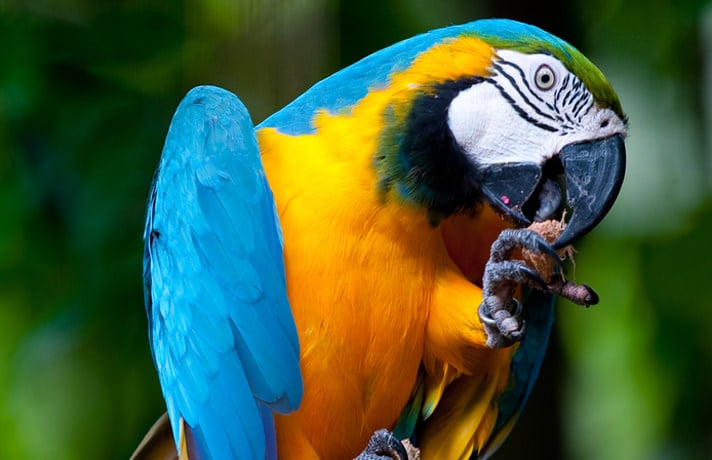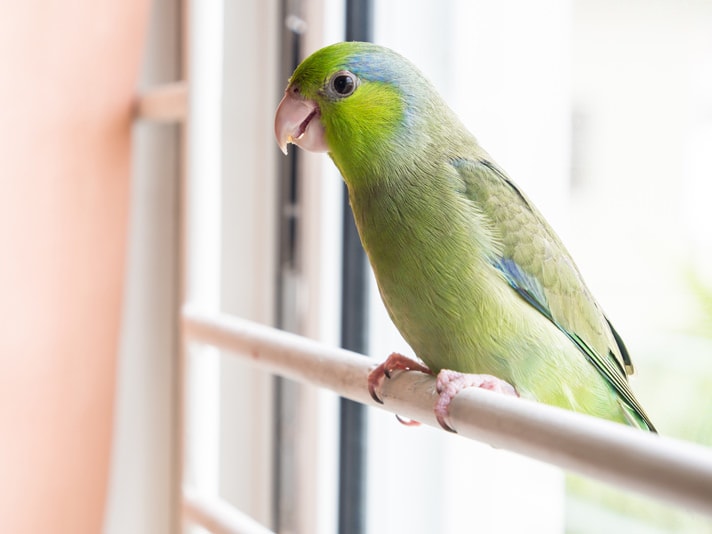Quaker parrots are illegal in several states, but they make great pets.
While the normal green and gray coloring of the quaker parrot does not immediately qualify it as a brightly colored bird, beauty is only feather deep. It is the character of the species that makes them stand out from other parrot species, said Giovanni Cordeiro, whose 40 years of experience with birds includes 10 years with quaker parrots.
Character, indeed. While every parrot species is different — as is every individual pet bird and parrot — there are several traits that make quakers, well, quakers.
Quaker Parrot Nests
Quaker parrots are unusual in that they come equipped with attitude, determination, intelligence and a desire to make and keep a home, said Ellen Krueger, a member of the Quaker Parakeet Society since 1999 and owner of quaker parrot Fonzie since 1996.
Think a parrot building a nest isn’t unusual? These aren’t your typical nests.
“These often large, dome-shaped clusters of sticks comprise multiple chambers, each occupied by a single pair for roosting and breeding. The human equivalent to this structure is an apartment building,” said Cordeiro, who has an honors degree in zoology and lives in Australia.
In fact, the nests are often comprised of three compartments or “rooms,” and are usually attached to other quaker nests in the wild, added Alyson Burgess, a quaker owner of three years in the southeast who is one of the avian experts at About.com. “These quaker ‘neighborhoods’ can become quite large and serve as evidence of the communal nature of the species. This inherent love of interaction makes them great pets for owners who want to form a close bond with their bird,” Burgess said.
While most quaker bird cages aren’t large enough to house an avian apartment building, quaker parrots still try.
“They also exhibit the building behavior in a domestic environment,” said Krueger. “They build, weave and create nests within their cages. That is so cool, you can’t believe it.”
And just like their human counterparts in apartments and houses, quakers parrots don’t always like drop-in guests. In fact, quakers can become extremely territorial of their nests.
“Most quaker owners report being attacked by their otherwise very gentle and loving pet when trying to retrieve them from within the cage,” Cordeiro said.
This might happen even without a nest in the cage. Quaker parrot territoriality has confused and concerned many a quaker owner, especially new ones.
“Not all quakers are territorial around their cages, but some are,” said Shelly Lane, who has had quaker parrots since 1995. “Unfortunately, a lot of new owners misunderstand and think that their bird suddenly turned mean on them, which isn’t the case at all. Their quaker is just displaying an instinctive behavior.”
Along with fiercely protecting their nests, quakers’ other common quirk is “borrowing” items from wherever.
Anything Is Up For Grabs With Quaker Parrots
“Without any doubt, what sets quakers apart from other parrots is a pack rat obsession with objects —retrieving and carrying them to their cage and carefully arranging them in the nest/cage,” said Kathleen Carr, who lives in the southeast with six quaker parrots.
And depending on what you’re missing, that behavior may be cute or not so much.
“Their natural instincts for building stick nests will provide hours of amused observation from their owners,” Cordeiro said. “By 1 year of age, both male and female quaker parrots will start stealing pens and other stick-like household objects to jam into various corners of the house or their cage. It may be many years later during a major cleanup that you eventually find your favorite gold pen stashed in some obscure part of the house.”
“We’ve had household items like pencils, forks and letter openers go missing that eventually turned up in a pet quaker’s nest,” Carr said. “One day, I came home from work for lunch and found my husband’s eyeglasses in one of the nests. He’s left them on the dining room table when he went to take a shower and didn’t check to make sure the door to our bird room was closed. Beaker, one of our males, made off with them and my very-puzzled husband had to wear his prescription sunglasses to drive to work.”
Life With Quaker Parrots
When considering whether a quaker parrot is right for you, ask yourself if you are right for a quaker.
“Quakers do best in homes where they are made to be part of the family and are included in daily activities,” Burgess said. “They thrive on socialization and are happy to spend the majority of their time with (or on) their owners.”
In a home where the attention supply doesn’t meet demand, a quaker parrot can start to exhibit some undesirable behavior.
“Not being the center of the universe is a good idea from the start, but dependable attention is a must to keep the bird friendly, busy and happy,” Krueger advised. “Quakers will, of course, take as much attention as anyone is willing to give. And once they’re used to it, they will count on it. They will have a hard time adjusting to not having it if it goes away.”
And as social as they are, even quakers need some solitude. They love company and interacting with the family, but also need time alone and a good night’s sleep, Krueger said. “A tired quaker is a noisy quaker that can be cranky.”
Squawk And Talk
Some quaker behavior is simply parrot behavior, not unique to the species.
“Like most parrots, they can be loud and can give a painful bite,” Krueger said. “Quakers have a loud, sharp squawk, but not the worst. If a quaker wants something and doesn’t get it right away, it will “Ack! Ack! Ack!” for long periods of time without stop. That’s the worst thing Fonzie does that annoys me.”
No look at quakers would be complete without addressing their considerable vocal abilities.
“While quakers do have the capacity to be loud when they want to be, they are generally one of the quieter parrot species,” Burgess said. “They will speak and chatter throughout the day at a moderate level but are not as prone to screaming as some birds, such as conures.”
The quaker parrot is known for its talking abilities, though there are, of course, no guarantees that a particular bird of any species will talk. “A quaker parrot that is spoken to at the hand-raising stage will start to use words as early as 3 months of age,” Cordeiro said. After about a year, they will pick up words relatively quickly, depending on the owner’s efforts.
Along with saying a potpourri of phrases, some quakers entertain their owners by seemingly speaking in context. “I would often wave and say goodbye to our companion quaker when leaving the house, and he recently surprised us when he said “bye bye” in response to just a wave of the hand,” Cordeiro said.
Lane’s quaker parrot, Gator, is particularly good with names.
“He knows my name, my husband’s name, the dog’s name and the names of most of the other birds,” she said. “There was a time when we had some quakers in another part of the house, so he could hear them but couldn’t see them. Apparently, this made it harder for him to learn their names. One day they were being rather noisy, and Gator yelled out to them, ‘Quaker! Quaker bird! Be quiet!’ To this day I don’t know how he picked up the phrase ‘Quaker bird,’ but the only time he uses it is to refer to a quaker whose name he doesn’t know.”
However, the quaker’s great mimicking ability may not always be so entertaining.
“If there is one behavior that a quaker owner will find highly amusing and yet somewhat disturbing is their ability to pick up on various bodily sounds: Sneezing, coughing, burping and, yes, breaking wind,” Cordeiro said. “The quaker parrot will also laugh with you, laugh at you or laugh at your friends.”
Friends Or Foes?
Carefully consider all potential roommates for your quaker parrot ?both avian and human. Experiences keeping quakers with other birds ranged from the good, the bad and the ugly.
“While some quaker parrots may take to other birds easily, others may never get along with another bird,” Cordeiro said. “Making the assumption that two unacquainted quaker parrots will get along just because they are of the same species is also foolhardy, just as it is to assume that throwing two humans into the same room will make them instant friends.”
Burgess has found quakers generally even tempered and tolerant of birds of other species. “Some quakers can show slight cage territoriality, possibly due to their nesting instinct.” For safety’s sake do not house a quaker with a bird of a different species.
Carr learned first-hand that not all quaker parrots get along with other birds. Two of her quakers broke out of their cage and into other birds’ cages. A cockatiel was seriously injured and a budgie didn’t survive the attack. “It goes without saying that I’ve figured out ways to better secure their cages, especially in the spring when their hormone levels intensify this behavior,” Carr said.
Krueger said that some are fine as only-birds, while others have a life partner that they would be very lonely without.
Caring for a pet bird can be a rewarding and enriching experience for a child. But in the case of quaker parrots, how young is too young?
“A certain level of respect should be given to the ability of any hooked bill bird to inflict injury to facial areas, particularly of toddlers and young children,” Cordeiro said. “While it is difficult to generalize the best age for a child to begin caring for another living creature, particularly one as opinionated as the quaker parrot, a person in their mid-teens would have a greater capacity to stand up to the demands of this parrot species.”
“Since quakers can be open with their opinions and their responses to things that go against their wishes, a child of 7 or less should always be supervised around a quaker,” said Krueger. “They can be loving and gentle with people they love, but they will also let anyone, including a child, know when the line has been crossed. A young teen or mature pre-teen could care for a quaker, but still, adult backup is a good idea. Again, education is a must before anyone of any age gets a quaker. Or any bird, for that matter.”
Along with human interaction, toys provide an important source of mental and physical stimulation for quaker parrots. They don’t need an iPod or an XBox like you, but quakers appreciate variety and things to occupy their time. Appropriate-sized bird toys are the same as those for cockatiels and small conures.
“Dismantling toys as opposed to playing with them is a highly rewarding task to the average quaker,” said Cordeiro. “When picking toys for the quaker, try obtaining those that are likely to stimulate the mind.” Also provide a mix of materials — chewable, climbable and indestructible — that hang in the cage or can be held.
Quaker parrot ownership depends on the individual person and the amount of research and time they’re willing to donate.
“If the person has read what to expect with a quaker and is prepared to give the kind of attention and stimulating environment a quaker needs, a quaker can be a wonderful first bird,” said Ellen Krueger, who has written and illustrated four childrens’ books about her quaker, Fonzie. “They are so smart and funny; they win people over with their personalities and talking ability.”
“Quakers are highly intelligent birds that know how to and will use their dominance to gain control of the less-experienced parrot owner,” said Australia’s Giovanni Cordeiro. “Without a full understanding of bird behavior, many new bird owners end up with a bird that will frustrate all their efforts in developing a well-behaved companion pet.”
In some ways, a quaker parrot might just combine the best of both worlds.
“Quakers are a little more challenging to build a relationship with than a budgie or cockatiel but are much easier than most larger species of parrots,” said Shelly Lane, who has operated the website QuakerParrots.com for more than 10 years. “A quaker is an excellent choice for a first-time bird owner, assuming that the new owner is willing to learn how to handle the bird and to work with it.”
Excerpt from BIRD TALK Magazine, September 2007 issue, with permission.
Featured Image: Via Yolanda/Flickr
Share:









